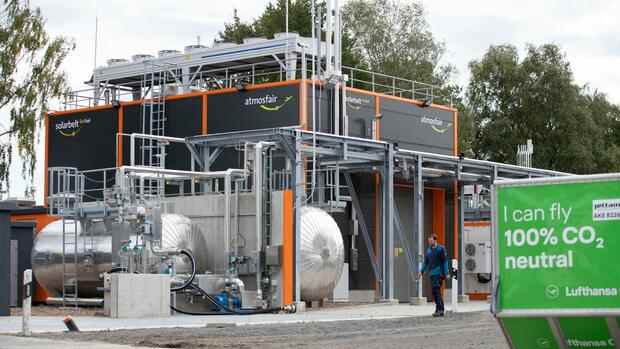Frankfurt Germany is pushing ahead with the industrial production of synthetically produced aviation fuel. The first production facility for sustainable kerosene was inaugurated on Monday in Werlte in Emsland. “Nobody wants to give up the dream of flying. That is why we need alternatives to conventional kerosene, ”said Federal Environment Minister Svenja Schulze (SPD). The project shows that the technology is available.
However, the data from the system show that the way to widespread use of the so-called SAF is still a long one. The new factory in Werlte will produce one tonne of the e-fuel per day. The annual production is therefore around 360 tons. For comparison: if the airlines in Germany have to add 0.5 percent SAF from 2026, as specified by the federal government, 50,000 tons per year will be necessary.
Nevertheless, the new plant in Werlte is an extremely important first step in the eyes of the aviation industry. She hopes that with the experience she has gained here, much larger factories will soon be built. “This system enables a completely different scaling,” said Dorothea von Boxberg, the head of Lufthansa Cargo, confidently. SAF is an opportunity to fly sustainably today and now.
The production facility in Werlte, which was built by the non-profit organization Atmosfair together with partners such as Siemens, Lufthansa and the energy supplier EWE, uses so-called power-to-liquid technology. E-fuel is produced from the two components CO2 and hydrogen in several process steps.
Top jobs of the day
Find the best jobs now and
be notified by email.
On the one hand, the CO2 is obtained during the fermentation of biomass and, on the other hand, it is taken directly from the air. “We don’t want the CO2 from the coal industry or the steel industry. Because then the calculation of decarbonization will not work, ”said Dietrich Brockhagen from Atmosfair.
Hydrogen is produced using wind energy
The hydrogen is in turn produced on site – with green electricity. This comes from local wind turbines, which will no longer receive EEG funding in the coming year. This ensures that the electricity demand is not at the expense of the energy transition, says Brockhagen. The synthetic fuel later only emits the CO2 that was previously taken from nature.
The increasingly stricter requirements for climate protection are giving the aviation industry a huge headache. In contrast to the automotive industry, there are so far few alternatives to the combustion engine. Electrically powered aircraft are being developed, but initially only on a small scale. Commercial use of such aircraft is still a few years away. The development of hydrogen aircraft will take even longer.
That is why airlines around the world rely heavily on synthetic kerosene. Not only can it be used in the existing turbines, storage and transport also do not require any new technologies. This makes SAF the fastest way to make flying climate-neutral. According to its own information, Lufthansa is already SAF’s largest customer in Europe.
The problem: There is still far too little e-fuel available. Sustainable fuel is also expensive. Atmosfair wants to market the kerosene produced in Werlte at the manufacturing price. But at around five euros per liter, it is still well above the around 1.85 euros that are currently being used for conventional kerosene. In order to make e-fuel cheaper, plants larger than those in Werlte are necessary. According to Brockhagen, this is not designed for decades of manufacture.
Customers reportedly willing to pay more for the ticket
There is another concern about aviation. The quota for SAF planned by the EU Commission could put European airlines at a disadvantage. You would have to add the more expensive e-kerosene for the entire long haul. In the case of a flight via a non-European hub, the quota would only be due for the flight to the transfer airport.
Lufthansa boss Carsten Spohr recently made this clear with this calculation: A flight from Madrid to Tokyo would cost the passenger around 30 euros more with an SAF rate of five percent via the Frankfurt hub, but only eight more for a competitor’s flight via Istanbul Euro. In Spohr’s view, given the low margins in aviation, this would be a clear distortion of competition.
But Brockhagen from Atmosfair is convinced that in the long run many customers would accept more expensive tickets in order to make flying climate-neutral. At least that applies to Atmosfair customers. A survey among them showed: “You are prepared to pay 80 to 100 euros more for a flight to Tenerife, for example.”
More: Expensive tickets, every service costs – how climate protection will change flying
